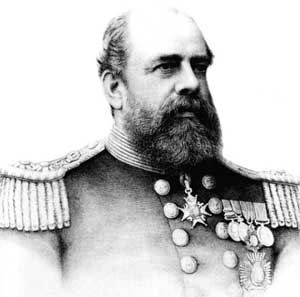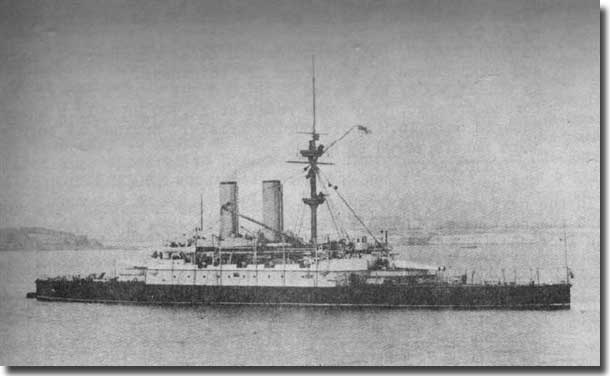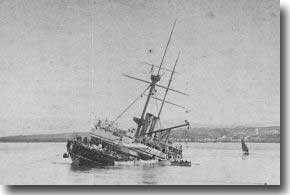|
Stupidity reigns and then Admirals collide
Introduction.
Drawing from the July issue of The Graphic 1893. HMS Victoria after her collision with HMS Camperdown. The cast. The Battleship HMS Victoria, had been launched in 1887, originally to be named Renown, but because she was ready to launch in Queen Victoria's Jubilee Year, she took the name of her Sovereign. This ship was the flagship of the Mediterranean Fleet, and Camperdown flew the flag of the second in command of that Fleet. The latter ship carried four by 13.5 inch guns in two turrets, one fitted fore, and the other aft. On the other hand, HMS Victoria was unusual, she had fitted a single turret forward with two huge Armstrong 16.25 inch guns, they weighed in at 110 tons each, and fired an amazing 1,600 pound shell. This ship displaced 10,420 tons, and had a sister ship Sans Pareil. Mediterranean Fleet. Admiral Tryon carried the reputation of being an expert Fleet handler, he certainly believed that to be true, but this story may well refute that belief. He discussed with his Flag Captain, the Staff Commander, and his Flag Lieutenant a complicated plan to bring his Fleet to anchor in splendid fashion.
Vice Admiral Sir George Tryon, in command of the British Mediterranean Fleet in 1893, flying his Flag in HMS Victoria. The Fleet in two columns ( or Divisions ) 1,200 yards apart, would steam away from the coast off Lebanon, with ships in column stationed 400 yards apart. The Admiral proposed to reverse course, with both columns turning inwards, the two ships leading the columns Victoria, and Camperdown, turning together, the ships following on behind, each pair turning in succession. After all ships had turned inwards, the columns 1,200 yards apart, would close up to 400 yards apart, then the Fleet would turn together 90 degrees to port, and when ordered, all ships would let go their anchors at the same time. It should be an evolution to watch and admire. Ten mighty ships all dropping anchor simultaneously. The Plan. Some doubts. The Admiral agreed with them verbally ( it seems to close that discussion ) because he still told his Flag Lieutenant to keep the columns at a distance of only 1,200 yards. On viewing this order, the Commander queried the distance with the Flag Lieutenant, who in turn, was brave enough to question his Admiral " Should the distance between columns be 1,600 yards or 1,200 yards SIR?" Vice Admiral Sir George Tryon testily told his Flag Lieutenant to "Leave the distance between columns at 1,200 yards." The seeds for disaster were now firmly sown!
HMS Camperdown Normal practice for column distances. The Fleet manoeuvre. Why one signal which simply ordered both columns to turn inwards 180 degrees was not ordered, I have no idea. Turning diameter of the two Battleships. The ten Captains remain silent. Rear Admiral Markham tries to query the Admiral's signal. Back in the Flagship, Admiral Tryon, impatient as ever, ordered Camperdown to show her pennants, he also belted off the signal: "What are you waiting for?" Rear Admiral Markham cancelled his proposed semaphore message, and completely wilted, by hoisting his answering pennant close up. THE DIE WAS CAST. Vice Admiral Tryon orders the manoeuvre. Captain Burke in Victoria has asked three times if he might go astern on his port screw before he gained approval, but too much time had elapsed, the two Battleships met halfway between their respective columns, with Camperdown running in to Victoria's starboard side with a sickening crash, and opening up a very large hole below her waterline. Camperdown's ram punched a hole 12 feel below the Flagship's waterline and penetrated some 9 feet inwards. The two ships swung together, the ram acting like a tin opener extended this breach to about 100 square feet, Victoria was mortally wounded. Just prior to the collision, "Close watertight doors, and out collision mat" was ordered in the Flagship, but it all happened so quickly that but a few watertight doors were closed in time. Water flooded in, entering a coal bunker, the ship listed quickly to starboard, which increased, as water streamed in through the gun ports. The stricken Victoria was down by her bows, and listing alarmingly, the bows went under, the stern rose, and the screws still turning, drove the bows even deeper towards the bottom. Within thirteen minutes the Flagship foundered, ABANDON SHIP was ordered, but the heavy list prevented many crew leaving the ship before she sank. 358, including Vice Admiral Sir George Tryon perished, 352 Officers and sailors were rescued.
HMS Camperdown after colliding with HMS Victoria Subsequent Court Martial. He responded that he had such faith in his superior officer, he thought that Admiral Tryon must have some trick up his sleeve. He thought that the C-in-C would execute the order for Markham's column to turn first, and when they had safely turned, then the second column would then be ordered to turn. Or, Tryon would use less rudder in turning Victoria and the first Division, thus turning well clear of the second Division. Of course neither of these suppositions came to pass. Commander John Jellicoe. Vice Admiral Sir George Tryon's last words. And the Court Martial Board agreed! Post Script. Christan Francis, a Lebanese Austrian, who has been searching for Victoria for 10 years, only discovered her in August 2004. Interestingly the British Commonwealth War Cemetery in Tripoli is named after HMS Victoria, the land donated by the Turkish Ottoman authorities to Britain in 1895.
HMS Victoria found in August of 2004, 111 years after her sinking by HMS Camperdown. The Last Word.
Bringing the Story Up To Date
|





